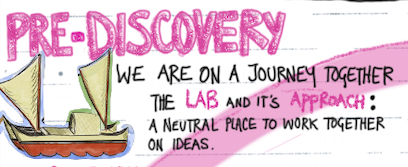Taking time to create a shared understanding of the opportunity
2. Pre-discovery phase
Purpose
This phase seeks to gather just enough information to describe in a concise way a potential initiative, for the purpose of making a decision to commit (ie funding, sponsorship, resources). AS part of the Lab’s operating model, this pre-discovery work was often resourced by the Lab prior to seeking project funding from comissionsers.
This time and focus helped make an informed decision about the nature of the opportunity, the readiness of the agencies and to better understand the resources requirements that may be required. Our experience highlighted all this information is key when seeking support from commissioners and sponsors.
- Mini-design sprint - getting close to the work
- Gathering just enough information to frame in a concise way a potential initiative,
- Will inform funding, sponsorship and resource requirements.
As part of the Lab’s operating model, this pre-discovery work was often resourced by the Lab prior to seeking project funding from comissionsers.
Features
- Resourced and funded by Lab
- Working quickly: 1-2 weeks
- Led by lab team working with partner agencies
- Seeking firm commitment from sponsors to progress research and design work
- Buy-in and resources required
- Project team (inc lab staff) formed
Activities / outputs
- Mini-design sprint or workshops
- Rapid user research
- Short design brief / proposal for prospective sponsors
- Early horizon scanning
- Inception deck document
Key lab team reflections for this phase
Develop a clear intent and scope, but hold it lightly
- Initial discovery work should support the development of a clear intent statement
- …but leave space to adapt and iterate in response to learning gain from subsequent phases
Starting thinking about value and resources
- Sizing - what resources will be needed and what’s available?
- What’s the opportunity cost (for the Lab) supporting this work? What other work will you need to say no too?
- What’s the reciprocal value for everyone involved?
Ensure clarity around the authorising environment
- Seek to understand and map your authorising environment, don’t assume it exists
- Take time to engage and frame the work with sponsors - not matter how good the idea their support will be crucial
- A lack of ownership at this stage creates a significant risk to implementation later


